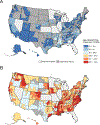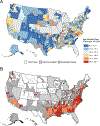Triple-negative breast cancer incidence in the United States: ecological correlations with area-level sociodemographics, healthcare, and health behaviors
- PMID: 32671723
- PMCID: PMC7796916
- DOI: 10.1007/s12282-020-01132-w
Triple-negative breast cancer incidence in the United States: ecological correlations with area-level sociodemographics, healthcare, and health behaviors
Abstract
Purpose: Triple-negative breast cancer (TNBC) is an aggressive subtype of breast cancer, more commonly diagnosed among black women than other subgroups. TNBC varies geographically, but little is known about area-level characteristics associated with elevated incidence.
Methods: We generated 2011-2013 age-adjusted TNBC incidence rates for state economic areas (SEAs) in 43 states using data from North American Association of Central Cancer Registries. For cases missing data on molecular markers, we imputed TNBC status using cross-marginal proportions. We linked these data to SEA covariates from national sources. Using linear ecological regression, we examined correlates of TNBC incidence rates for the overall population and for age (< 50 years or 50 + years)- or race (white or black)-specific subgroups.
Results: The mean annual incidence of TNBC across SEAs was 13.7 per 100,000 women (range = 4.5-26.3), with especially high and variable rates among African American women (mean = 20.5, range 0.0-155.1). TNBC incidence was highest in South Atlantic and East South Central Census Divisions and lowest in Mountain Division. Overall TNBC incidence was associated with SEA sociodemographics (e.g., percent of females age 45 + who are non-Hispanic black: coefficient estimate [est.] = 1.62), healthcare characteristics (e.g., percent of population without health insurance: est. = - 0.52), and health behaviors (e.g., prevalence of obesity among women: est. = 0.72) (all p < 0.05). Other variables related to TNBC incidence included density of obstetrician/gynecologists and prevalence of smoking.
Conclusion: TNBC incidence varied across SEAs in the U.S., particularly for African American women. Identifying areas with elevated TNBC incidence can facilitate research and interventions on area- and individual-level correlates of TNBC.
Keywords: Geographic disparities; Health behaviors; Healthcare; Sociodemographics; Triple-negative breast cancer.
Conflict of interest statement
Figures



References
-
- National Cancer Institute. Cancer stat facts: Female breast cancer. 2018; https://seer.cancer.gov/statfacts/html/breast.html, 2018.
-
- Bauer KR, Brown M, Cress RD, Parise CA, Caggiano V. Descriptive analysis of estrogen receptor (ER)-negative, progesterone receptor (PR)-negative, and HER2-negative invasive breast cancer, the so-called triple-negative phenotype. Cancer. 2007;109(9):1721–1728. - PubMed
-
- Carey LA, Perou CM, Livasy CA, et al. Race, breast cancer subtypes, and survival in the Carolina Breast Cancer Study. Jama. 2006;295(21):2492–2502. - PubMed
-
- Dawood S. Triple-negative breast cancer. Drugs. 2010;70(17):2247–2258. - PubMed
MeSH terms
Grants and funding
LinkOut - more resources
Full Text Sources
Research Materials

